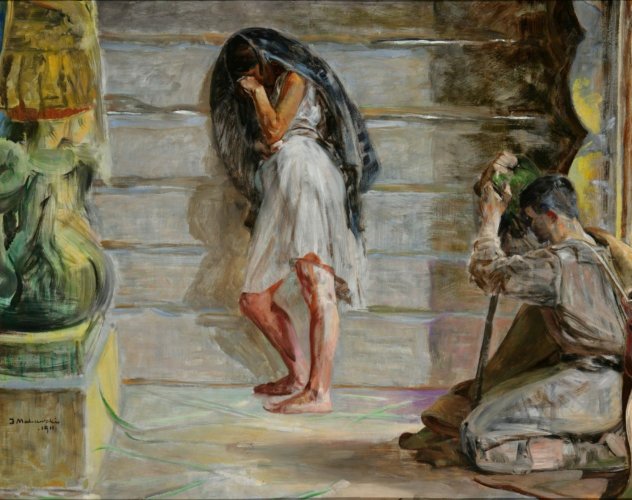Description:
Jacek Malczewski (1854-1929) had a love for art and Romantic literature, particularly the poetry of Juliusz Słowacki, which he inherited from his family. He came from a noble, though impoverished, family. His father, Julian, supported him in his career as a painter. The events of 1863, the January Uprising and subsequent repression, had a particular impact on the young artist. His first teacher was Adolf Dygasiński. From 1867 to 1871 he spent his youth at the manor of his Karczewski relatives in Wielgiem. In 1873 he began studying at the Krakow Academy of Fine Arts under the tutelage of Jan Matejko. He was a student of Władysław Łuszczkiewicz and also studied at the École des Beaux-Arts in Paris. He traveled to Italy, Vienna, Munich, Greece, and Asia Minor. From 1896 to 1900 and 1910 to 1914 he was a professor at the Academy of Fine Arts in Krakow, and from 1912 to 1914 he was its rector. He began with idealizing realism, then moved on to naturalism, with the fate of exiles to Siberia and the inspiration of Juliusz Słowacki’s Anhellim as dominant themes in his work during this period. At the same time, fantastical and allegorical elements began to appear in Malczewski’s work. After his father’s death in 1884, Thanatos, the god of death, became a recurring motif in Malczewski’s work. After 1890, his art became thoroughly symbolic. Works manifesting his turn towards Symbolist style included Introdukcja (1890), Melancholia (1890-1894), and Błędne koło (1895-1897). He addressed existential, historical, and artistic topics, weaving ancient and biblical themes with native folklore and the Polish landscape, which was so important to his work. Form, colour, monumentality of his representations, and their expressiveness became his hallmarks.
Description of the painting:
“Farewell” by Jacek Malczewski depicts a scene that cannot be interpreted unambiguously. Two figures are shown in a room in which food is stored. The woman, in a gesture of sorrow and helplessness, hid her face in her hands. She stood with her back turned to the visitor, who had knelt at the threshold. The relationship between the painted characters, their identities and the presented theme are all unclear. The portrayal is often associated with receiving news of the death of a Siberian exile. There is also a theme referring to the artist’s personal life.
In 1911, an incredibly difficult year for Jacek Malczewski, his brother-in-law, Wacław Karczewski, died as a result of the Rapperswil affair, a topic which was discussed and explored in the work “Erynie,” completed around the same time. In that same year, the artist had to say goodbye to his beloved daughter, Julia, who was married against her will to a much older landowner under pressure from her mother. Julia moved away from the bustling cultural city she loved so much, to a peaceful village*. Thus, in his personal life, Malczewski had several reasons to say goodbye. On a broader, patriotic scale, the title of the work could have been connected to the constant struggle to regain independence, with more and more casualties being mourned by their loved ones every day. The title of the work was taken from the 1938 “Guide to the Rogaliński Gallery.” It was previously referred to as “untitled.”
On the picture two figures are presented. A middle-aged man and a young woman. The woman, almost in the center of the composition, stands upright. She has a head-scarf on her head. Her face, in a gesture of sadness and despair, is hidden in her hands. She is dressed in a white dress. Her feet remain bare. On the right side of the picture a kneeling wanderer is painted. He is dressed in a tattered outfit. He has a Siberian coat thrown over his shoulder. He supports himself on a wooden stick. His face is hidden in the greenish cap taken off his head, held in both hands like a relic. The figures are inside a small room built of logs. The man kneels at the entrance to it, illuminated by the yellow rays of the setting sun that come from outside. On a small elevation large pitchers are placed. Above them hang unspecified objects. On the floor scattered vegetables resembling young onions. This allows us to assume that the figures have been placed in a pantry, a temporary place for storing food.
In such a scene a meeting of a woman and a man takes place. From her reaction we can conclude that she received a sad information about the necessity to go away, die, go to the battlefield. She is helpless. The gesture of the kneeling man, perhaps an unreal apparition (it is significant that the woman turned her back to the visitor, as if not seeing him) can be interpreted on the one hand as waiting for a blessing, on the other as humbly paying homage, expressing regret, or humbly admitting guilt and waiting for forgiveness. Both figures remain anonymous, their facial features and unambiguous intentions are undiscovered.


